Strategic Analysis Report: AirAsia Malaysia's Performance
VerifiedAdded on 2022/12/28
|18
|5338
|68
Report
AI Summary
This report conducts a strategic analysis of AirAsia Malaysia, examining its internal and external environments to understand its performance. It begins with a company background and outlines its vision and mission. The analysis includes a detailed SWOT analysis, identifying strengths, weaknesses, opportunities, and threats. Porter's five forces analysis is used to assess the competitive landscape, evaluating the bargaining power of buyers and suppliers, the threat of new entrants and substitutes, and industry rivalry. The report also incorporates a resource-based view, examining tangible and intangible resources to determine competitive advantages. Finally, the report concludes with recommendations for AirAsia Malaysia to maintain and enhance its competitive position in the market.
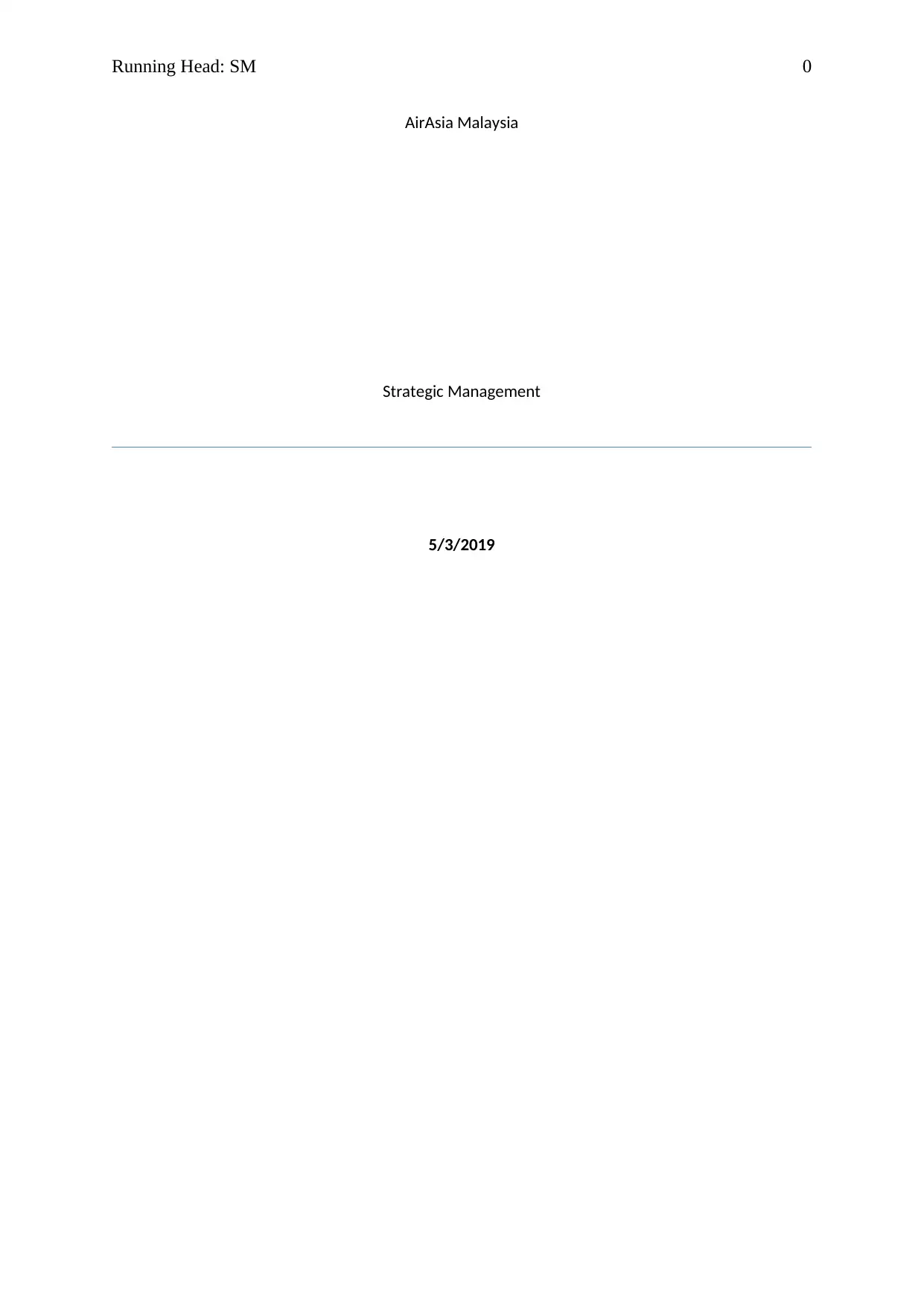
Running Head: SM 0
AirAsia Malaysia
Strategic Management
5/3/2019
AirAsia Malaysia
Strategic Management
5/3/2019
Paraphrase This Document
Need a fresh take? Get an instant paraphrase of this document with our AI Paraphraser
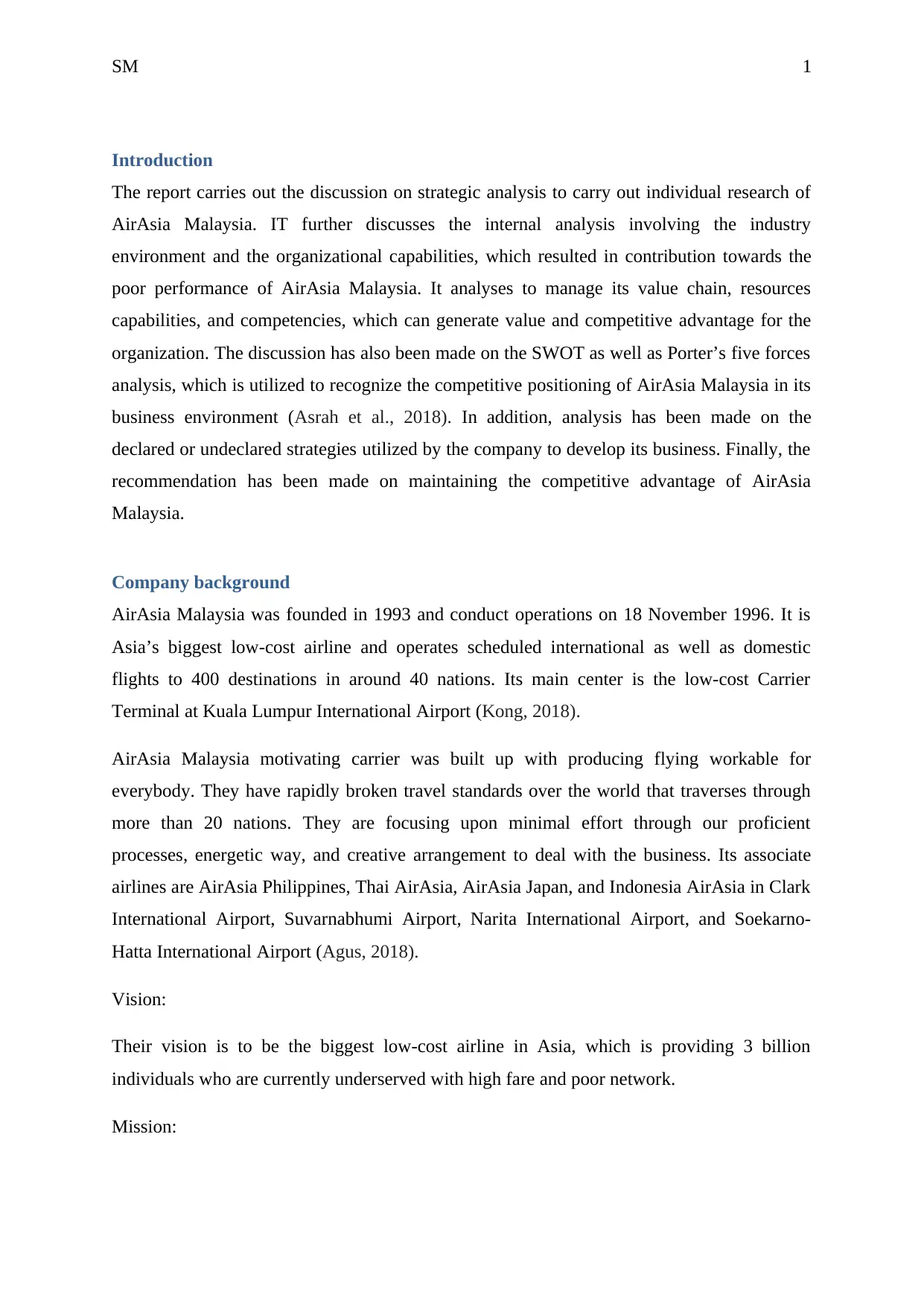
SM 1
Introduction
The report carries out the discussion on strategic analysis to carry out individual research of
AirAsia Malaysia. IT further discusses the internal analysis involving the industry
environment and the organizational capabilities, which resulted in contribution towards the
poor performance of AirAsia Malaysia. It analyses to manage its value chain, resources
capabilities, and competencies, which can generate value and competitive advantage for the
organization. The discussion has also been made on the SWOT as well as Porter’s five forces
analysis, which is utilized to recognize the competitive positioning of AirAsia Malaysia in its
business environment (Asrah et al., 2018). In addition, analysis has been made on the
declared or undeclared strategies utilized by the company to develop its business. Finally, the
recommendation has been made on maintaining the competitive advantage of AirAsia
Malaysia.
Company background
AirAsia Malaysia was founded in 1993 and conduct operations on 18 November 1996. It is
Asia’s biggest low-cost airline and operates scheduled international as well as domestic
flights to 400 destinations in around 40 nations. Its main center is the low-cost Carrier
Terminal at Kuala Lumpur International Airport (Kong, 2018).
AirAsia Malaysia motivating carrier was built up with producing flying workable for
everybody. They have rapidly broken travel standards over the world that traverses through
more than 20 nations. They are focusing upon minimal effort through our proficient
processes, energetic way, and creative arrangement to deal with the business. Its associate
airlines are AirAsia Philippines, Thai AirAsia, AirAsia Japan, and Indonesia AirAsia in Clark
International Airport, Suvarnabhumi Airport, Narita International Airport, and Soekarno-
Hatta International Airport (Agus, 2018).
Vision:
Their vision is to be the biggest low-cost airline in Asia, which is providing 3 billion
individuals who are currently underserved with high fare and poor network.
Mission:
Introduction
The report carries out the discussion on strategic analysis to carry out individual research of
AirAsia Malaysia. IT further discusses the internal analysis involving the industry
environment and the organizational capabilities, which resulted in contribution towards the
poor performance of AirAsia Malaysia. It analyses to manage its value chain, resources
capabilities, and competencies, which can generate value and competitive advantage for the
organization. The discussion has also been made on the SWOT as well as Porter’s five forces
analysis, which is utilized to recognize the competitive positioning of AirAsia Malaysia in its
business environment (Asrah et al., 2018). In addition, analysis has been made on the
declared or undeclared strategies utilized by the company to develop its business. Finally, the
recommendation has been made on maintaining the competitive advantage of AirAsia
Malaysia.
Company background
AirAsia Malaysia was founded in 1993 and conduct operations on 18 November 1996. It is
Asia’s biggest low-cost airline and operates scheduled international as well as domestic
flights to 400 destinations in around 40 nations. Its main center is the low-cost Carrier
Terminal at Kuala Lumpur International Airport (Kong, 2018).
AirAsia Malaysia motivating carrier was built up with producing flying workable for
everybody. They have rapidly broken travel standards over the world that traverses through
more than 20 nations. They are focusing upon minimal effort through our proficient
processes, energetic way, and creative arrangement to deal with the business. Its associate
airlines are AirAsia Philippines, Thai AirAsia, AirAsia Japan, and Indonesia AirAsia in Clark
International Airport, Suvarnabhumi Airport, Narita International Airport, and Soekarno-
Hatta International Airport (Agus, 2018).
Vision:
Their vision is to be the biggest low-cost airline in Asia, which is providing 3 billion
individuals who are currently underserved with high fare and poor network.
Mission:
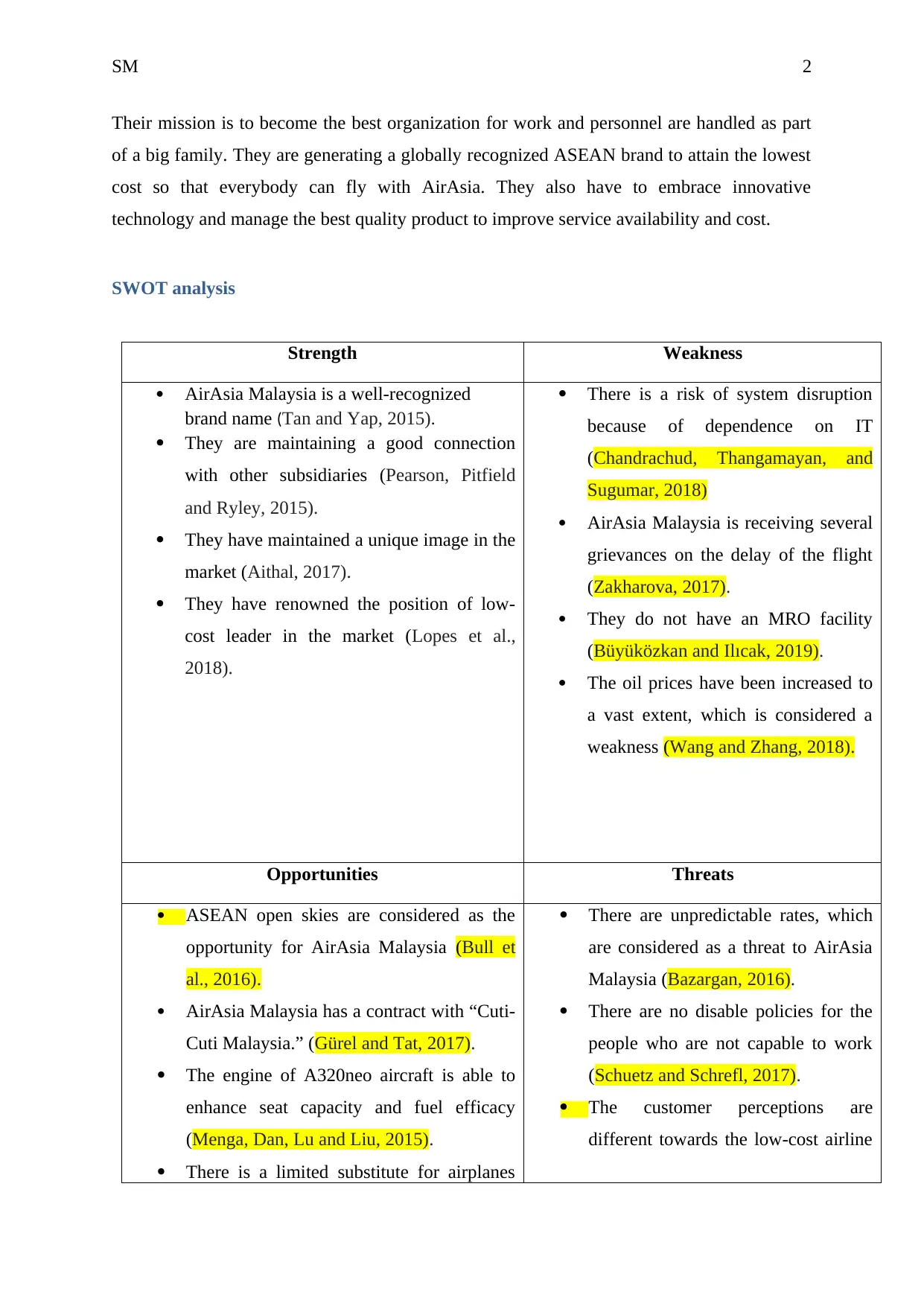
SM 2
Their mission is to become the best organization for work and personnel are handled as part
of a big family. They are generating a globally recognized ASEAN brand to attain the lowest
cost so that everybody can fly with AirAsia. They also have to embrace innovative
technology and manage the best quality product to improve service availability and cost.
SWOT analysis
Strength Weakness
AirAsia Malaysia is a well-recognized
brand name (Tan and Yap, 2015).
They are maintaining a good connection
with other subsidiaries (Pearson, Pitfield
and Ryley, 2015).
They have maintained a unique image in the
market (Aithal, 2017).
They have renowned the position of low-
cost leader in the market (Lopes et al.,
2018).
There is a risk of system disruption
because of dependence on IT
(Chandrachud, Thangamayan, and
Sugumar, 2018)
AirAsia Malaysia is receiving several
grievances on the delay of the flight
(Zakharova, 2017).
They do not have an MRO facility
(Büyüközkan and Ilıcak, 2019).
The oil prices have been increased to
a vast extent, which is considered a
weakness (Wang and Zhang, 2018).
Opportunities Threats
ASEAN open skies are considered as the
opportunity for AirAsia Malaysia (Bull et
al., 2016).
AirAsia Malaysia has a contract with “Cuti-
Cuti Malaysia.” (Gürel and Tat, 2017).
The engine of A320neo aircraft is able to
enhance seat capacity and fuel efficacy
(Menga, Dan, Lu and Liu, 2015).
There is a limited substitute for airplanes
There are unpredictable rates, which
are considered as a threat to AirAsia
Malaysia (Bazargan, 2016).
There are no disable policies for the
people who are not capable to work
(Schuetz and Schrefl, 2017).
The customer perceptions are
different towards the low-cost airline
Their mission is to become the best organization for work and personnel are handled as part
of a big family. They are generating a globally recognized ASEAN brand to attain the lowest
cost so that everybody can fly with AirAsia. They also have to embrace innovative
technology and manage the best quality product to improve service availability and cost.
SWOT analysis
Strength Weakness
AirAsia Malaysia is a well-recognized
brand name (Tan and Yap, 2015).
They are maintaining a good connection
with other subsidiaries (Pearson, Pitfield
and Ryley, 2015).
They have maintained a unique image in the
market (Aithal, 2017).
They have renowned the position of low-
cost leader in the market (Lopes et al.,
2018).
There is a risk of system disruption
because of dependence on IT
(Chandrachud, Thangamayan, and
Sugumar, 2018)
AirAsia Malaysia is receiving several
grievances on the delay of the flight
(Zakharova, 2017).
They do not have an MRO facility
(Büyüközkan and Ilıcak, 2019).
The oil prices have been increased to
a vast extent, which is considered a
weakness (Wang and Zhang, 2018).
Opportunities Threats
ASEAN open skies are considered as the
opportunity for AirAsia Malaysia (Bull et
al., 2016).
AirAsia Malaysia has a contract with “Cuti-
Cuti Malaysia.” (Gürel and Tat, 2017).
The engine of A320neo aircraft is able to
enhance seat capacity and fuel efficacy
(Menga, Dan, Lu and Liu, 2015).
There is a limited substitute for airplanes
There are unpredictable rates, which
are considered as a threat to AirAsia
Malaysia (Bazargan, 2016).
There are no disable policies for the
people who are not capable to work
(Schuetz and Schrefl, 2017).
The customer perceptions are
different towards the low-cost airline
⊘ This is a preview!⊘
Do you want full access?
Subscribe today to unlock all pages.

Trusted by 1+ million students worldwide
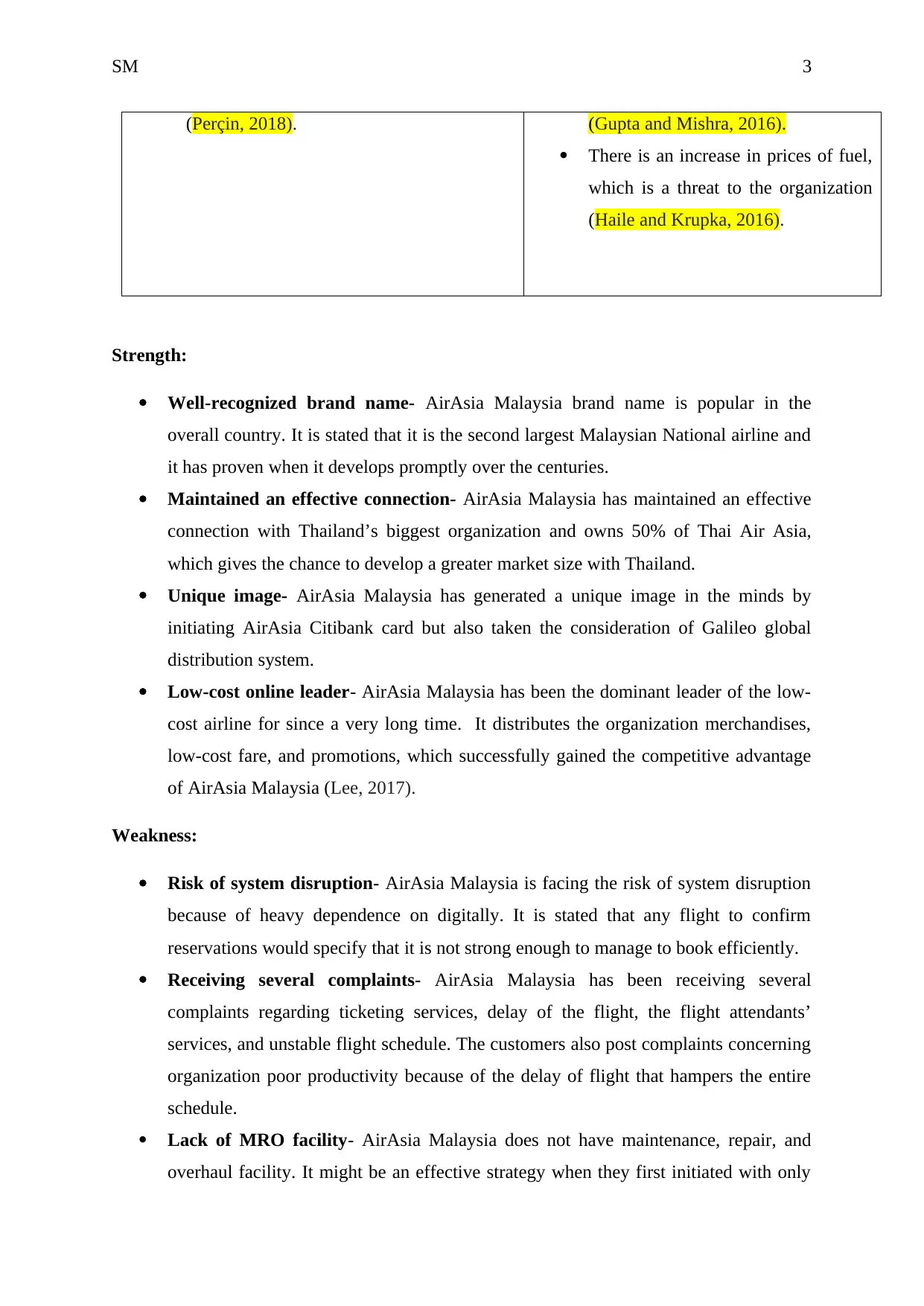
SM 3
(Perçin, 2018). (Gupta and Mishra, 2016).
There is an increase in prices of fuel,
which is a threat to the organization
(Haile and Krupka, 2016).
Strength:
Well-recognized brand name- AirAsia Malaysia brand name is popular in the
overall country. It is stated that it is the second largest Malaysian National airline and
it has proven when it develops promptly over the centuries.
Maintained an effective connection- AirAsia Malaysia has maintained an effective
connection with Thailand’s biggest organization and owns 50% of Thai Air Asia,
which gives the chance to develop a greater market size with Thailand.
Unique image- AirAsia Malaysia has generated a unique image in the minds by
initiating AirAsia Citibank card but also taken the consideration of Galileo global
distribution system.
Low-cost online leader- AirAsia Malaysia has been the dominant leader of the low-
cost airline for since a very long time. It distributes the organization merchandises,
low-cost fare, and promotions, which successfully gained the competitive advantage
of AirAsia Malaysia (Lee, 2017).
Weakness:
Risk of system disruption- AirAsia Malaysia is facing the risk of system disruption
because of heavy dependence on digitally. It is stated that any flight to confirm
reservations would specify that it is not strong enough to manage to book efficiently.
Receiving several complaints- AirAsia Malaysia has been receiving several
complaints regarding ticketing services, delay of the flight, the flight attendants’
services, and unstable flight schedule. The customers also post complaints concerning
organization poor productivity because of the delay of flight that hampers the entire
schedule.
Lack of MRO facility- AirAsia Malaysia does not have maintenance, repair, and
overhaul facility. It might be an effective strategy when they first initiated with only
(Perçin, 2018). (Gupta and Mishra, 2016).
There is an increase in prices of fuel,
which is a threat to the organization
(Haile and Krupka, 2016).
Strength:
Well-recognized brand name- AirAsia Malaysia brand name is popular in the
overall country. It is stated that it is the second largest Malaysian National airline and
it has proven when it develops promptly over the centuries.
Maintained an effective connection- AirAsia Malaysia has maintained an effective
connection with Thailand’s biggest organization and owns 50% of Thai Air Asia,
which gives the chance to develop a greater market size with Thailand.
Unique image- AirAsia Malaysia has generated a unique image in the minds by
initiating AirAsia Citibank card but also taken the consideration of Galileo global
distribution system.
Low-cost online leader- AirAsia Malaysia has been the dominant leader of the low-
cost airline for since a very long time. It distributes the organization merchandises,
low-cost fare, and promotions, which successfully gained the competitive advantage
of AirAsia Malaysia (Lee, 2017).
Weakness:
Risk of system disruption- AirAsia Malaysia is facing the risk of system disruption
because of heavy dependence on digitally. It is stated that any flight to confirm
reservations would specify that it is not strong enough to manage to book efficiently.
Receiving several complaints- AirAsia Malaysia has been receiving several
complaints regarding ticketing services, delay of the flight, the flight attendants’
services, and unstable flight schedule. The customers also post complaints concerning
organization poor productivity because of the delay of flight that hampers the entire
schedule.
Lack of MRO facility- AirAsia Malaysia does not have maintenance, repair, and
overhaul facility. It might be an effective strategy when they first initiated with only
Paraphrase This Document
Need a fresh take? Get an instant paraphrase of this document with our AI Paraphraser
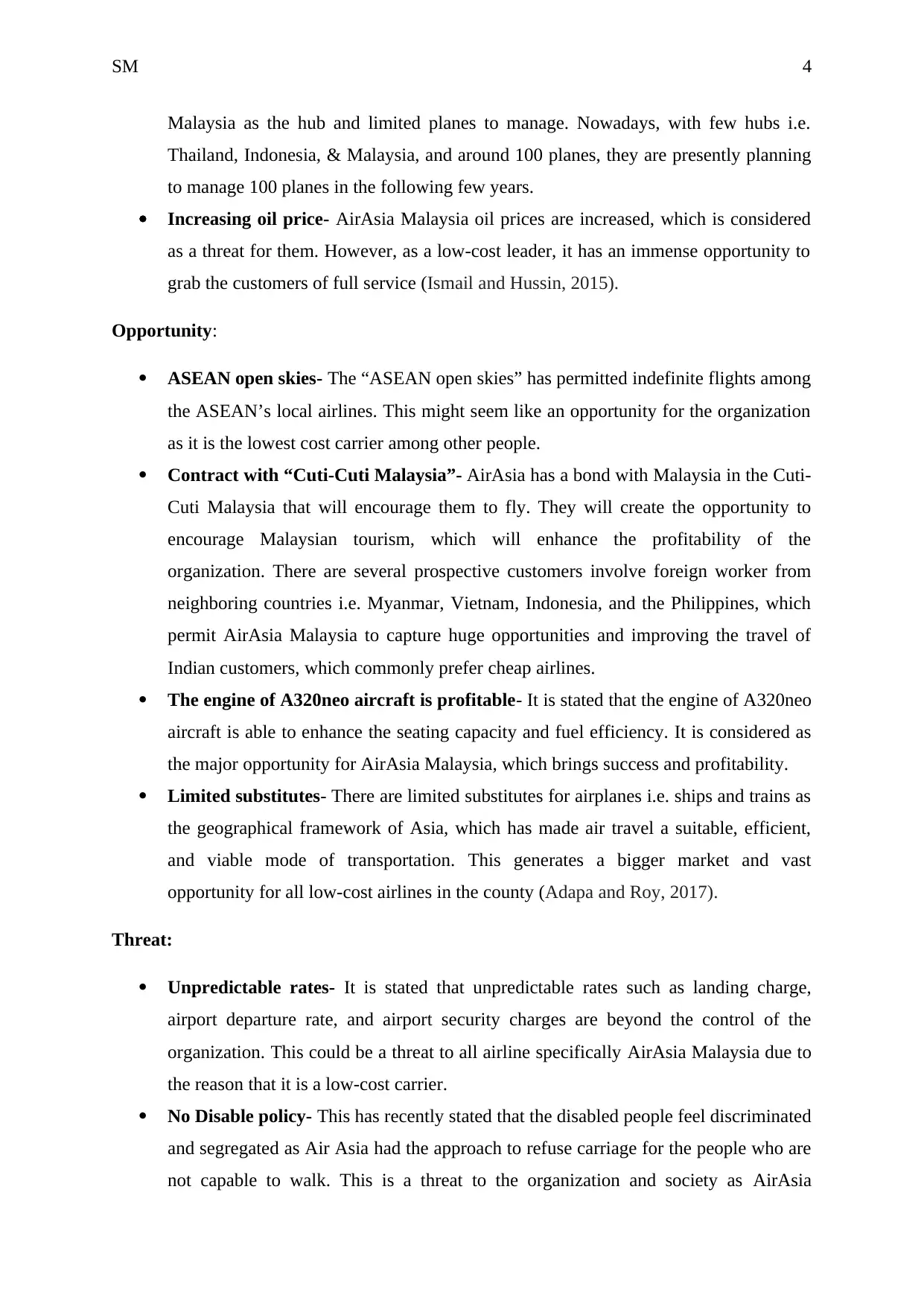
SM 4
Malaysia as the hub and limited planes to manage. Nowadays, with few hubs i.e.
Thailand, Indonesia, & Malaysia, and around 100 planes, they are presently planning
to manage 100 planes in the following few years.
Increasing oil price- AirAsia Malaysia oil prices are increased, which is considered
as a threat for them. However, as a low-cost leader, it has an immense opportunity to
grab the customers of full service (Ismail and Hussin, 2015).
Opportunity:
ASEAN open skies- The “ASEAN open skies” has permitted indefinite flights among
the ASEAN’s local airlines. This might seem like an opportunity for the organization
as it is the lowest cost carrier among other people.
Contract with “Cuti-Cuti Malaysia”- AirAsia has a bond with Malaysia in the Cuti-
Cuti Malaysia that will encourage them to fly. They will create the opportunity to
encourage Malaysian tourism, which will enhance the profitability of the
organization. There are several prospective customers involve foreign worker from
neighboring countries i.e. Myanmar, Vietnam, Indonesia, and the Philippines, which
permit AirAsia Malaysia to capture huge opportunities and improving the travel of
Indian customers, which commonly prefer cheap airlines.
The engine of A320neo aircraft is profitable- It is stated that the engine of A320neo
aircraft is able to enhance the seating capacity and fuel efficiency. It is considered as
the major opportunity for AirAsia Malaysia, which brings success and profitability.
Limited substitutes- There are limited substitutes for airplanes i.e. ships and trains as
the geographical framework of Asia, which has made air travel a suitable, efficient,
and viable mode of transportation. This generates a bigger market and vast
opportunity for all low-cost airlines in the county (Adapa and Roy, 2017).
Threat:
Unpredictable rates- It is stated that unpredictable rates such as landing charge,
airport departure rate, and airport security charges are beyond the control of the
organization. This could be a threat to all airline specifically AirAsia Malaysia due to
the reason that it is a low-cost carrier.
No Disable policy- This has recently stated that the disabled people feel discriminated
and segregated as Air Asia had the approach to refuse carriage for the people who are
not capable to walk. This is a threat to the organization and society as AirAsia
Malaysia as the hub and limited planes to manage. Nowadays, with few hubs i.e.
Thailand, Indonesia, & Malaysia, and around 100 planes, they are presently planning
to manage 100 planes in the following few years.
Increasing oil price- AirAsia Malaysia oil prices are increased, which is considered
as a threat for them. However, as a low-cost leader, it has an immense opportunity to
grab the customers of full service (Ismail and Hussin, 2015).
Opportunity:
ASEAN open skies- The “ASEAN open skies” has permitted indefinite flights among
the ASEAN’s local airlines. This might seem like an opportunity for the organization
as it is the lowest cost carrier among other people.
Contract with “Cuti-Cuti Malaysia”- AirAsia has a bond with Malaysia in the Cuti-
Cuti Malaysia that will encourage them to fly. They will create the opportunity to
encourage Malaysian tourism, which will enhance the profitability of the
organization. There are several prospective customers involve foreign worker from
neighboring countries i.e. Myanmar, Vietnam, Indonesia, and the Philippines, which
permit AirAsia Malaysia to capture huge opportunities and improving the travel of
Indian customers, which commonly prefer cheap airlines.
The engine of A320neo aircraft is profitable- It is stated that the engine of A320neo
aircraft is able to enhance the seating capacity and fuel efficiency. It is considered as
the major opportunity for AirAsia Malaysia, which brings success and profitability.
Limited substitutes- There are limited substitutes for airplanes i.e. ships and trains as
the geographical framework of Asia, which has made air travel a suitable, efficient,
and viable mode of transportation. This generates a bigger market and vast
opportunity for all low-cost airlines in the county (Adapa and Roy, 2017).
Threat:
Unpredictable rates- It is stated that unpredictable rates such as landing charge,
airport departure rate, and airport security charges are beyond the control of the
organization. This could be a threat to all airline specifically AirAsia Malaysia due to
the reason that it is a low-cost carrier.
No Disable policy- This has recently stated that the disabled people feel discriminated
and segregated as Air Asia had the approach to refuse carriage for the people who are
not capable to walk. This is a threat to the organization and society as AirAsia
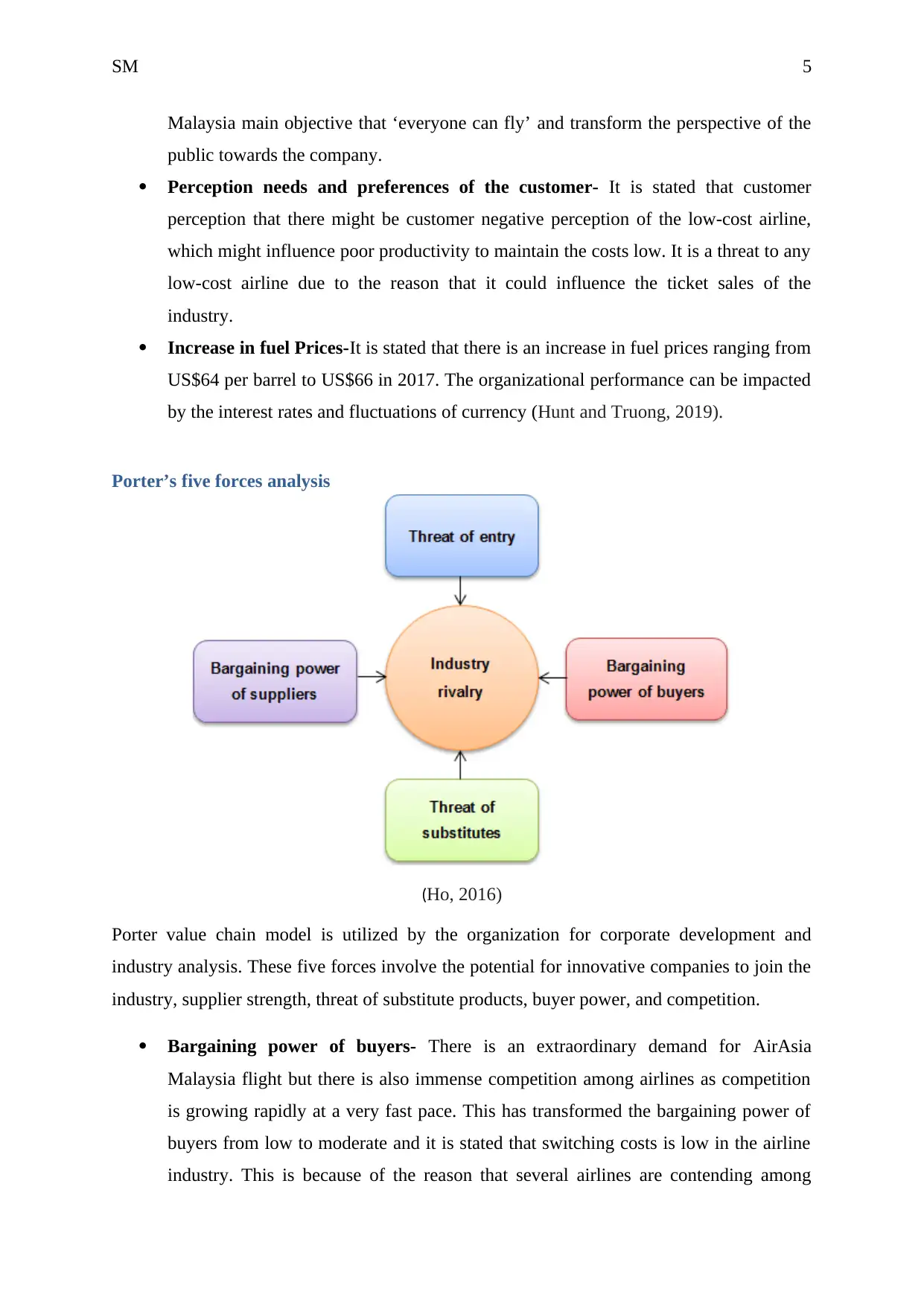
SM 5
Malaysia main objective that ‘everyone can fly’ and transform the perspective of the
public towards the company.
Perception needs and preferences of the customer- It is stated that customer
perception that there might be customer negative perception of the low-cost airline,
which might influence poor productivity to maintain the costs low. It is a threat to any
low-cost airline due to the reason that it could influence the ticket sales of the
industry.
Increase in fuel Prices-It is stated that there is an increase in fuel prices ranging from
US$64 per barrel to US$66 in 2017. The organizational performance can be impacted
by the interest rates and fluctuations of currency (Hunt and Truong, 2019).
Porter’s five forces analysis
(Ho, 2016)
Porter value chain model is utilized by the organization for corporate development and
industry analysis. These five forces involve the potential for innovative companies to join the
industry, supplier strength, threat of substitute products, buyer power, and competition.
Bargaining power of buyers- There is an extraordinary demand for AirAsia
Malaysia flight but there is also immense competition among airlines as competition
is growing rapidly at a very fast pace. This has transformed the bargaining power of
buyers from low to moderate and it is stated that switching costs is low in the airline
industry. This is because of the reason that several airlines are contending among
Malaysia main objective that ‘everyone can fly’ and transform the perspective of the
public towards the company.
Perception needs and preferences of the customer- It is stated that customer
perception that there might be customer negative perception of the low-cost airline,
which might influence poor productivity to maintain the costs low. It is a threat to any
low-cost airline due to the reason that it could influence the ticket sales of the
industry.
Increase in fuel Prices-It is stated that there is an increase in fuel prices ranging from
US$64 per barrel to US$66 in 2017. The organizational performance can be impacted
by the interest rates and fluctuations of currency (Hunt and Truong, 2019).
Porter’s five forces analysis
(Ho, 2016)
Porter value chain model is utilized by the organization for corporate development and
industry analysis. These five forces involve the potential for innovative companies to join the
industry, supplier strength, threat of substitute products, buyer power, and competition.
Bargaining power of buyers- There is an extraordinary demand for AirAsia
Malaysia flight but there is also immense competition among airlines as competition
is growing rapidly at a very fast pace. This has transformed the bargaining power of
buyers from low to moderate and it is stated that switching costs is low in the airline
industry. This is because of the reason that several airlines are contending among
⊘ This is a preview!⊘
Do you want full access?
Subscribe today to unlock all pages.

Trusted by 1+ million students worldwide

SM 6
similar seats and services. The comparison has been made by AirAsia Malaysia
regarding airfares, which can be done through websites like cheap flights and
Expedia. However, customers are more capable to compare budget airline through the
internet, which probably gives more alternatives and resulting in the increased
bargaining power of buyers (Lohmann and Spasojevic, 2018).
The threat of new entrants- It is stated that developing an airline service needs huge
investment. AirAsia Malaysia should expend either on acquiring aircraft or on
advertising, which requires a huge workforce and a vast amount of start-up capital. As
per KPMG analysis, it has been stated that there is an approximated growth and
profitability from 62000 people in 2011 to 117000 people in 2018. It is not easy to get
a license of operating aircraft as the administration imposes fixed and specific legal
binding rules to control and standardize the safety level of every airline industry.
Bargaining power of suppliers- Supplier can be a source of power over the
enterprise. It is stated that to mitigate the issues of the bargaining power of suppliers,
AirAsia Malaysia has implemented an ERP system and fasten the data restoration
process. Airbus and Boeing monopolized aircraft manufacturing. There were also
inadequate fuel suppliers in the existing market, which can impact the long-term
business collaboration. The switching cost is high because the aircraft and their
maintenance are costly and there are rare substitutes available for the aircraft that
covers the long distance in a shorter span (Messner, 2017).
The threat of substitutes- The threat of substitutes for the brand AirAsia Malaysia
within the Asian counties is high. It is stated that presently most of the countries
ranging to ASEAN region are developing counties. The landed transport and railways
still become a reasonable choice in ASEAN countries are comparable to domestic air
transport. The customer might also opt for rail or bus services when traveling from
Singapore to Malaysia, which delivered lower fare and conscious of the
environmental influence of utilizing air travel.
Industry rivalry- For most industries, the intense competitive rivalry among
competitors is the key factor that influences the profitability and success of AirAsia
Malaysia. The competitors of AirAsia Malaysia are Firefly and MAS, which directly
and indirectly influences their growth rate. The demand has been increased because of
globalization, which has triggered the intense rivalry and growth of new Low-Cost
Carriers (LCCs) among the airline industry. The technology has further intensified the
price war among the players of AirAsia Malaysia as the customer can comfortably
similar seats and services. The comparison has been made by AirAsia Malaysia
regarding airfares, which can be done through websites like cheap flights and
Expedia. However, customers are more capable to compare budget airline through the
internet, which probably gives more alternatives and resulting in the increased
bargaining power of buyers (Lohmann and Spasojevic, 2018).
The threat of new entrants- It is stated that developing an airline service needs huge
investment. AirAsia Malaysia should expend either on acquiring aircraft or on
advertising, which requires a huge workforce and a vast amount of start-up capital. As
per KPMG analysis, it has been stated that there is an approximated growth and
profitability from 62000 people in 2011 to 117000 people in 2018. It is not easy to get
a license of operating aircraft as the administration imposes fixed and specific legal
binding rules to control and standardize the safety level of every airline industry.
Bargaining power of suppliers- Supplier can be a source of power over the
enterprise. It is stated that to mitigate the issues of the bargaining power of suppliers,
AirAsia Malaysia has implemented an ERP system and fasten the data restoration
process. Airbus and Boeing monopolized aircraft manufacturing. There were also
inadequate fuel suppliers in the existing market, which can impact the long-term
business collaboration. The switching cost is high because the aircraft and their
maintenance are costly and there are rare substitutes available for the aircraft that
covers the long distance in a shorter span (Messner, 2017).
The threat of substitutes- The threat of substitutes for the brand AirAsia Malaysia
within the Asian counties is high. It is stated that presently most of the countries
ranging to ASEAN region are developing counties. The landed transport and railways
still become a reasonable choice in ASEAN countries are comparable to domestic air
transport. The customer might also opt for rail or bus services when traveling from
Singapore to Malaysia, which delivered lower fare and conscious of the
environmental influence of utilizing air travel.
Industry rivalry- For most industries, the intense competitive rivalry among
competitors is the key factor that influences the profitability and success of AirAsia
Malaysia. The competitors of AirAsia Malaysia are Firefly and MAS, which directly
and indirectly influences their growth rate. The demand has been increased because of
globalization, which has triggered the intense rivalry and growth of new Low-Cost
Carriers (LCCs) among the airline industry. The technology has further intensified the
price war among the players of AirAsia Malaysia as the customer can comfortably
Paraphrase This Document
Need a fresh take? Get an instant paraphrase of this document with our AI Paraphraser
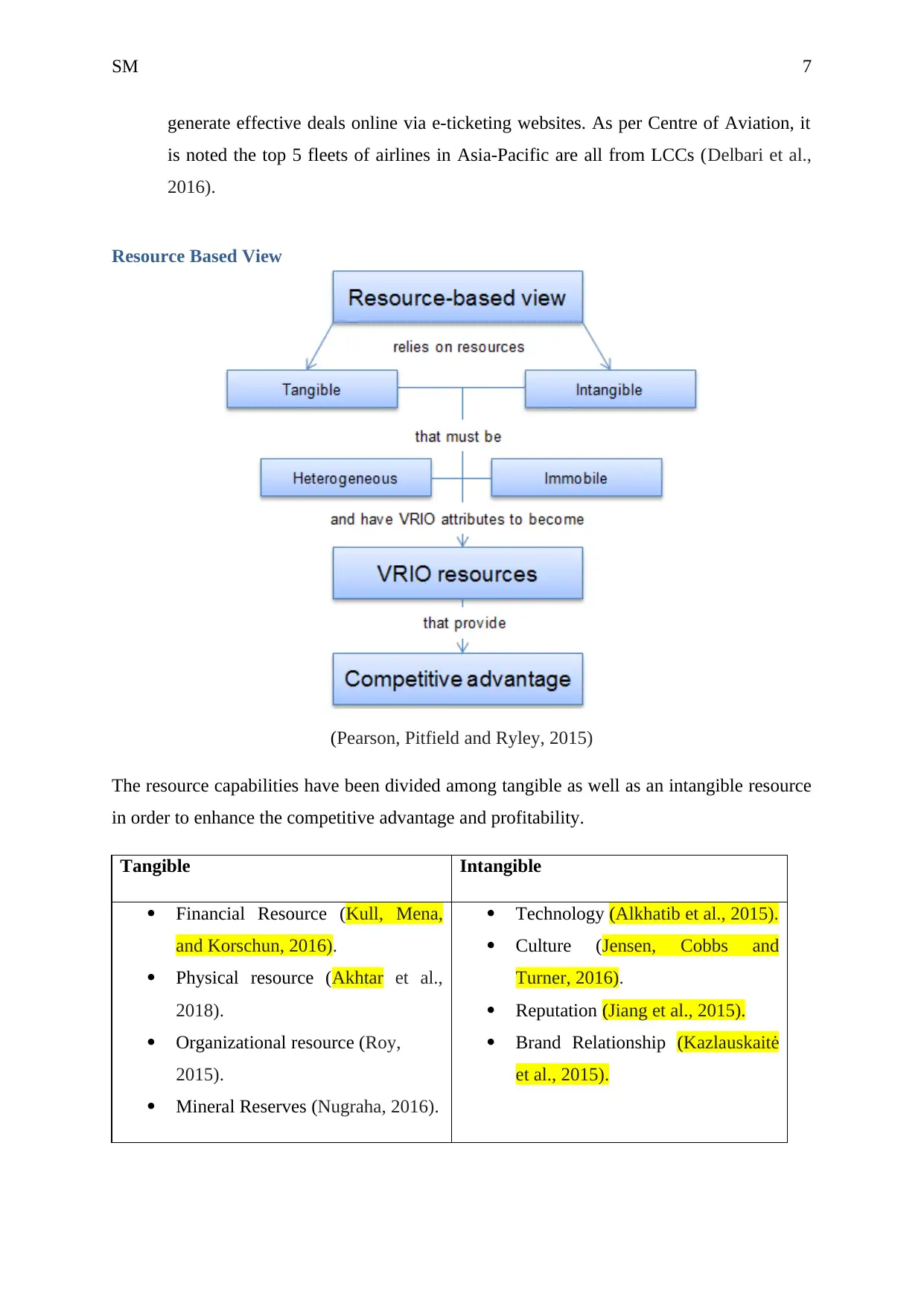
SM 7
generate effective deals online via e-ticketing websites. As per Centre of Aviation, it
is noted the top 5 fleets of airlines in Asia-Pacific are all from LCCs (Delbari et al.,
2016).
Resource Based View
(Pearson, Pitfield and Ryley, 2015)
The resource capabilities have been divided among tangible as well as an intangible resource
in order to enhance the competitive advantage and profitability.
Tangible Intangible
Financial Resource (Kull, Mena,
and Korschun, 2016).
Physical resource (Akhtar et al.,
2018).
Organizational resource (Roy,
2015).
Mineral Reserves (Nugraha, 2016).
Technology (Alkhatib et al., 2015).
Culture (Jensen, Cobbs and
Turner, 2016).
Reputation (Jiang et al., 2015).
Brand Relationship (Kazlauskaitė
et al., 2015).
generate effective deals online via e-ticketing websites. As per Centre of Aviation, it
is noted the top 5 fleets of airlines in Asia-Pacific are all from LCCs (Delbari et al.,
2016).
Resource Based View
(Pearson, Pitfield and Ryley, 2015)
The resource capabilities have been divided among tangible as well as an intangible resource
in order to enhance the competitive advantage and profitability.
Tangible Intangible
Financial Resource (Kull, Mena,
and Korschun, 2016).
Physical resource (Akhtar et al.,
2018).
Organizational resource (Roy,
2015).
Mineral Reserves (Nugraha, 2016).
Technology (Alkhatib et al., 2015).
Culture (Jensen, Cobbs and
Turner, 2016).
Reputation (Jiang et al., 2015).
Brand Relationship (Kazlauskaitė
et al., 2015).
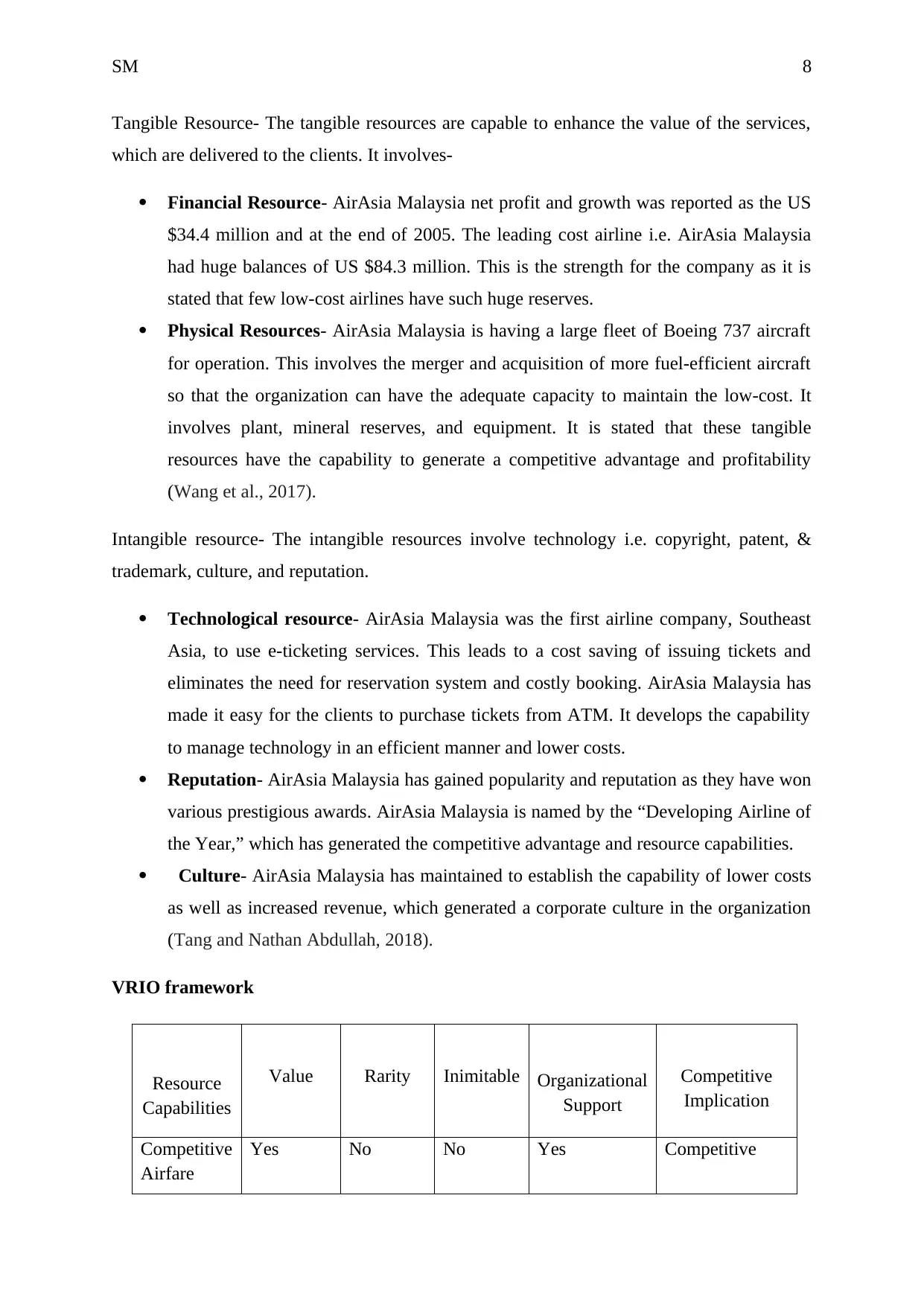
SM 8
Tangible Resource- The tangible resources are capable to enhance the value of the services,
which are delivered to the clients. It involves-
Financial Resource- AirAsia Malaysia net profit and growth was reported as the US
$34.4 million and at the end of 2005. The leading cost airline i.e. AirAsia Malaysia
had huge balances of US $84.3 million. This is the strength for the company as it is
stated that few low-cost airlines have such huge reserves.
Physical Resources- AirAsia Malaysia is having a large fleet of Boeing 737 aircraft
for operation. This involves the merger and acquisition of more fuel-efficient aircraft
so that the organization can have the adequate capacity to maintain the low-cost. It
involves plant, mineral reserves, and equipment. It is stated that these tangible
resources have the capability to generate a competitive advantage and profitability
(Wang et al., 2017).
Intangible resource- The intangible resources involve technology i.e. copyright, patent, &
trademark, culture, and reputation.
Technological resource- AirAsia Malaysia was the first airline company, Southeast
Asia, to use e-ticketing services. This leads to a cost saving of issuing tickets and
eliminates the need for reservation system and costly booking. AirAsia Malaysia has
made it easy for the clients to purchase tickets from ATM. It develops the capability
to manage technology in an efficient manner and lower costs.
Reputation- AirAsia Malaysia has gained popularity and reputation as they have won
various prestigious awards. AirAsia Malaysia is named by the “Developing Airline of
the Year,” which has generated the competitive advantage and resource capabilities.
Culture- AirAsia Malaysia has maintained to establish the capability of lower costs
as well as increased revenue, which generated a corporate culture in the organization
(Tang and Nathan Abdullah, 2018).
VRIO framework
Resource
Capabilities
Value Rarity Inimitable Organizational
Support
Competitive
Implication
Competitive
Airfare
Yes No No Yes Competitive
Tangible Resource- The tangible resources are capable to enhance the value of the services,
which are delivered to the clients. It involves-
Financial Resource- AirAsia Malaysia net profit and growth was reported as the US
$34.4 million and at the end of 2005. The leading cost airline i.e. AirAsia Malaysia
had huge balances of US $84.3 million. This is the strength for the company as it is
stated that few low-cost airlines have such huge reserves.
Physical Resources- AirAsia Malaysia is having a large fleet of Boeing 737 aircraft
for operation. This involves the merger and acquisition of more fuel-efficient aircraft
so that the organization can have the adequate capacity to maintain the low-cost. It
involves plant, mineral reserves, and equipment. It is stated that these tangible
resources have the capability to generate a competitive advantage and profitability
(Wang et al., 2017).
Intangible resource- The intangible resources involve technology i.e. copyright, patent, &
trademark, culture, and reputation.
Technological resource- AirAsia Malaysia was the first airline company, Southeast
Asia, to use e-ticketing services. This leads to a cost saving of issuing tickets and
eliminates the need for reservation system and costly booking. AirAsia Malaysia has
made it easy for the clients to purchase tickets from ATM. It develops the capability
to manage technology in an efficient manner and lower costs.
Reputation- AirAsia Malaysia has gained popularity and reputation as they have won
various prestigious awards. AirAsia Malaysia is named by the “Developing Airline of
the Year,” which has generated the competitive advantage and resource capabilities.
Culture- AirAsia Malaysia has maintained to establish the capability of lower costs
as well as increased revenue, which generated a corporate culture in the organization
(Tang and Nathan Abdullah, 2018).
VRIO framework
Resource
Capabilities
Value Rarity Inimitable Organizational
Support
Competitive
Implication
Competitive
Airfare
Yes No No Yes Competitive
⊘ This is a preview!⊘
Do you want full access?
Subscribe today to unlock all pages.

Trusted by 1+ million students worldwide
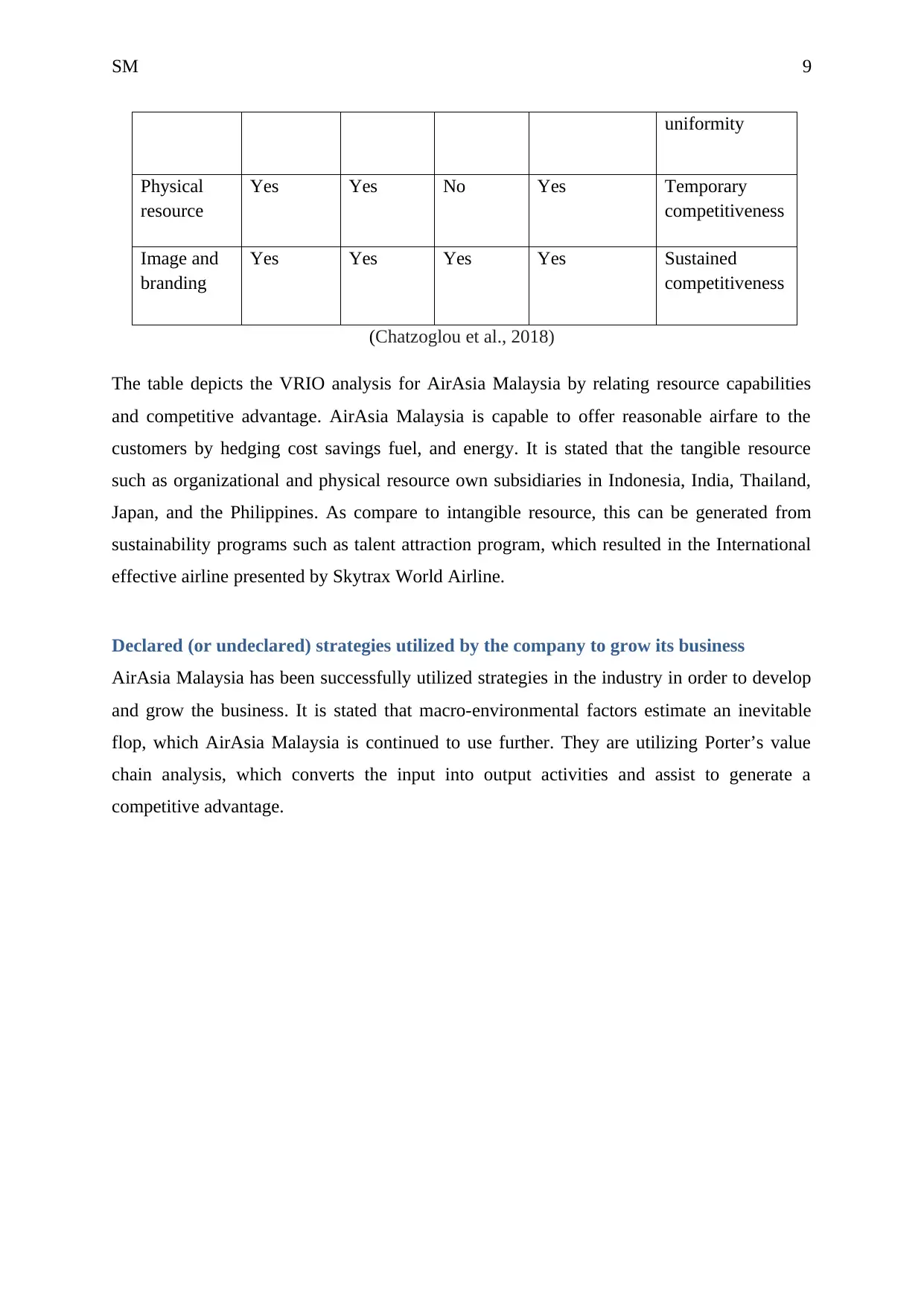
SM 9
uniformity
Physical
resource
Yes Yes No Yes Temporary
competitiveness
Image and
branding
Yes Yes Yes Yes Sustained
competitiveness
(Chatzoglou et al., 2018)
The table depicts the VRIO analysis for AirAsia Malaysia by relating resource capabilities
and competitive advantage. AirAsia Malaysia is capable to offer reasonable airfare to the
customers by hedging cost savings fuel, and energy. It is stated that the tangible resource
such as organizational and physical resource own subsidiaries in Indonesia, India, Thailand,
Japan, and the Philippines. As compare to intangible resource, this can be generated from
sustainability programs such as talent attraction program, which resulted in the International
effective airline presented by Skytrax World Airline.
Declared (or undeclared) strategies utilized by the company to grow its business
AirAsia Malaysia has been successfully utilized strategies in the industry in order to develop
and grow the business. It is stated that macro-environmental factors estimate an inevitable
flop, which AirAsia Malaysia is continued to use further. They are utilizing Porter’s value
chain analysis, which converts the input into output activities and assist to generate a
competitive advantage.
uniformity
Physical
resource
Yes Yes No Yes Temporary
competitiveness
Image and
branding
Yes Yes Yes Yes Sustained
competitiveness
(Chatzoglou et al., 2018)
The table depicts the VRIO analysis for AirAsia Malaysia by relating resource capabilities
and competitive advantage. AirAsia Malaysia is capable to offer reasonable airfare to the
customers by hedging cost savings fuel, and energy. It is stated that the tangible resource
such as organizational and physical resource own subsidiaries in Indonesia, India, Thailand,
Japan, and the Philippines. As compare to intangible resource, this can be generated from
sustainability programs such as talent attraction program, which resulted in the International
effective airline presented by Skytrax World Airline.
Declared (or undeclared) strategies utilized by the company to grow its business
AirAsia Malaysia has been successfully utilized strategies in the industry in order to develop
and grow the business. It is stated that macro-environmental factors estimate an inevitable
flop, which AirAsia Malaysia is continued to use further. They are utilizing Porter’s value
chain analysis, which converts the input into output activities and assist to generate a
competitive advantage.
Paraphrase This Document
Need a fresh take? Get an instant paraphrase of this document with our AI Paraphraser
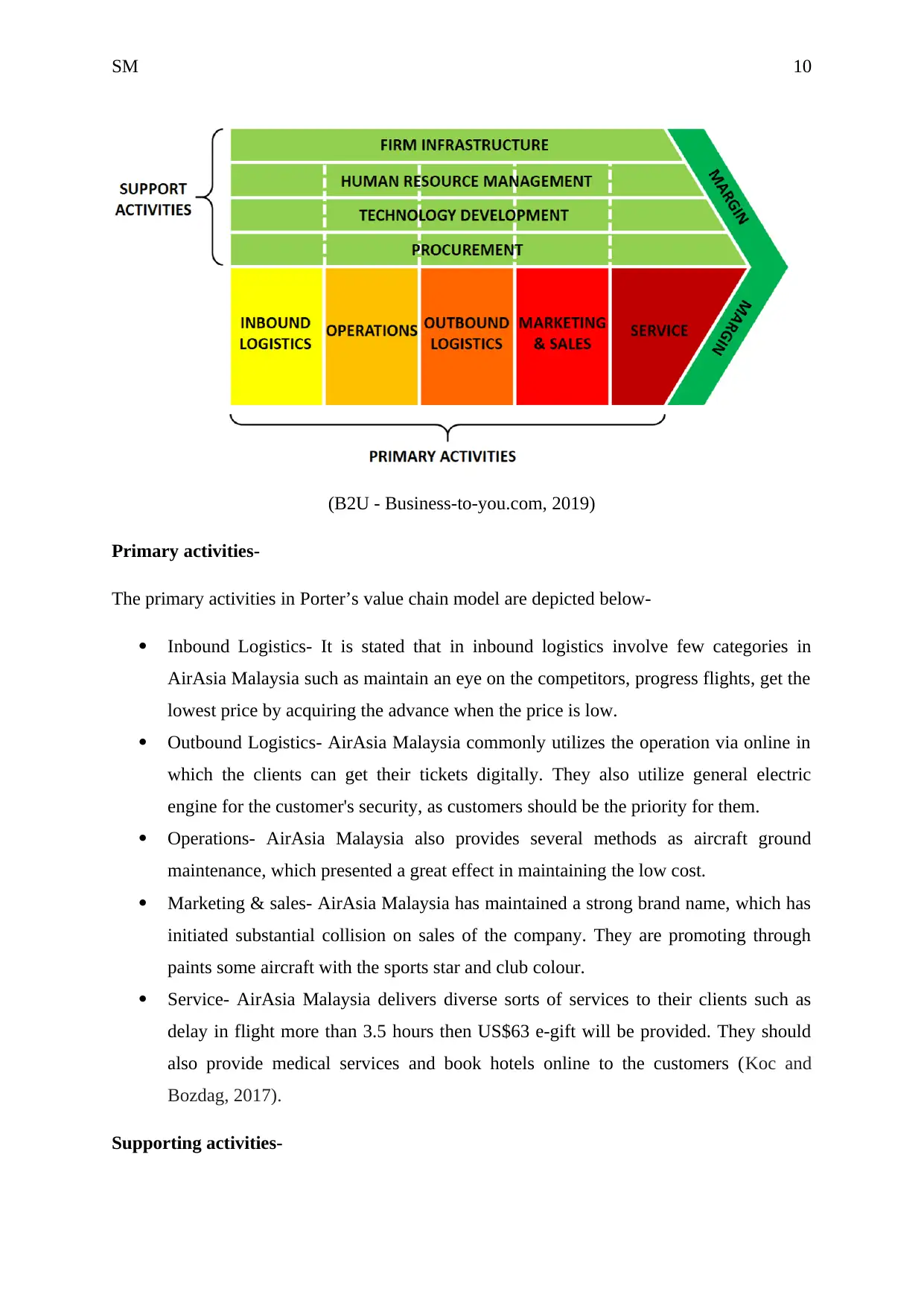
SM 10
(B2U - Business-to-you.com, 2019)
Primary activities-
The primary activities in Porter’s value chain model are depicted below-
Inbound Logistics- It is stated that in inbound logistics involve few categories in
AirAsia Malaysia such as maintain an eye on the competitors, progress flights, get the
lowest price by acquiring the advance when the price is low.
Outbound Logistics- AirAsia Malaysia commonly utilizes the operation via online in
which the clients can get their tickets digitally. They also utilize general electric
engine for the customer's security, as customers should be the priority for them.
Operations- AirAsia Malaysia also provides several methods as aircraft ground
maintenance, which presented a great effect in maintaining the low cost.
Marketing & sales- AirAsia Malaysia has maintained a strong brand name, which has
initiated substantial collision on sales of the company. They are promoting through
paints some aircraft with the sports star and club colour.
Service- AirAsia Malaysia delivers diverse sorts of services to their clients such as
delay in flight more than 3.5 hours then US$63 e-gift will be provided. They should
also provide medical services and book hotels online to the customers (Koc and
Bozdag, 2017).
Supporting activities-
(B2U - Business-to-you.com, 2019)
Primary activities-
The primary activities in Porter’s value chain model are depicted below-
Inbound Logistics- It is stated that in inbound logistics involve few categories in
AirAsia Malaysia such as maintain an eye on the competitors, progress flights, get the
lowest price by acquiring the advance when the price is low.
Outbound Logistics- AirAsia Malaysia commonly utilizes the operation via online in
which the clients can get their tickets digitally. They also utilize general electric
engine for the customer's security, as customers should be the priority for them.
Operations- AirAsia Malaysia also provides several methods as aircraft ground
maintenance, which presented a great effect in maintaining the low cost.
Marketing & sales- AirAsia Malaysia has maintained a strong brand name, which has
initiated substantial collision on sales of the company. They are promoting through
paints some aircraft with the sports star and club colour.
Service- AirAsia Malaysia delivers diverse sorts of services to their clients such as
delay in flight more than 3.5 hours then US$63 e-gift will be provided. They should
also provide medical services and book hotels online to the customers (Koc and
Bozdag, 2017).
Supporting activities-
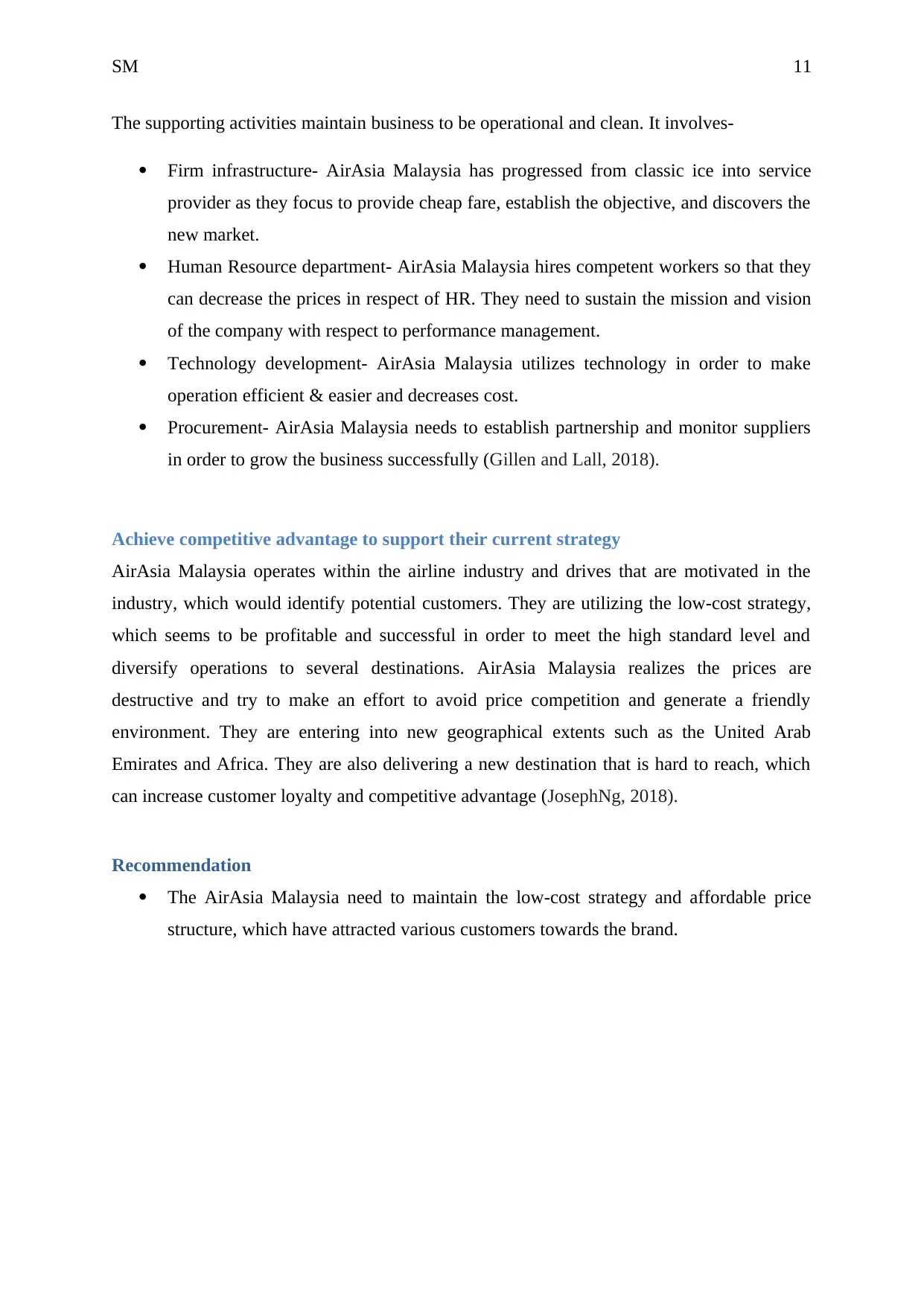
SM 11
The supporting activities maintain business to be operational and clean. It involves-
Firm infrastructure- AirAsia Malaysia has progressed from classic ice into service
provider as they focus to provide cheap fare, establish the objective, and discovers the
new market.
Human Resource department- AirAsia Malaysia hires competent workers so that they
can decrease the prices in respect of HR. They need to sustain the mission and vision
of the company with respect to performance management.
Technology development- AirAsia Malaysia utilizes technology in order to make
operation efficient & easier and decreases cost.
Procurement- AirAsia Malaysia needs to establish partnership and monitor suppliers
in order to grow the business successfully (Gillen and Lall, 2018).
Achieve competitive advantage to support their current strategy
AirAsia Malaysia operates within the airline industry and drives that are motivated in the
industry, which would identify potential customers. They are utilizing the low-cost strategy,
which seems to be profitable and successful in order to meet the high standard level and
diversify operations to several destinations. AirAsia Malaysia realizes the prices are
destructive and try to make an effort to avoid price competition and generate a friendly
environment. They are entering into new geographical extents such as the United Arab
Emirates and Africa. They are also delivering a new destination that is hard to reach, which
can increase customer loyalty and competitive advantage (JosephNg, 2018).
Recommendation
The AirAsia Malaysia need to maintain the low-cost strategy and affordable price
structure, which have attracted various customers towards the brand.
The supporting activities maintain business to be operational and clean. It involves-
Firm infrastructure- AirAsia Malaysia has progressed from classic ice into service
provider as they focus to provide cheap fare, establish the objective, and discovers the
new market.
Human Resource department- AirAsia Malaysia hires competent workers so that they
can decrease the prices in respect of HR. They need to sustain the mission and vision
of the company with respect to performance management.
Technology development- AirAsia Malaysia utilizes technology in order to make
operation efficient & easier and decreases cost.
Procurement- AirAsia Malaysia needs to establish partnership and monitor suppliers
in order to grow the business successfully (Gillen and Lall, 2018).
Achieve competitive advantage to support their current strategy
AirAsia Malaysia operates within the airline industry and drives that are motivated in the
industry, which would identify potential customers. They are utilizing the low-cost strategy,
which seems to be profitable and successful in order to meet the high standard level and
diversify operations to several destinations. AirAsia Malaysia realizes the prices are
destructive and try to make an effort to avoid price competition and generate a friendly
environment. They are entering into new geographical extents such as the United Arab
Emirates and Africa. They are also delivering a new destination that is hard to reach, which
can increase customer loyalty and competitive advantage (JosephNg, 2018).
Recommendation
The AirAsia Malaysia need to maintain the low-cost strategy and affordable price
structure, which have attracted various customers towards the brand.
⊘ This is a preview!⊘
Do you want full access?
Subscribe today to unlock all pages.

Trusted by 1+ million students worldwide
1 out of 18
Related Documents
Your All-in-One AI-Powered Toolkit for Academic Success.
+13062052269
info@desklib.com
Available 24*7 on WhatsApp / Email
![[object Object]](/_next/static/media/star-bottom.7253800d.svg)
Unlock your academic potential
Copyright © 2020–2026 A2Z Services. All Rights Reserved. Developed and managed by ZUCOL.





